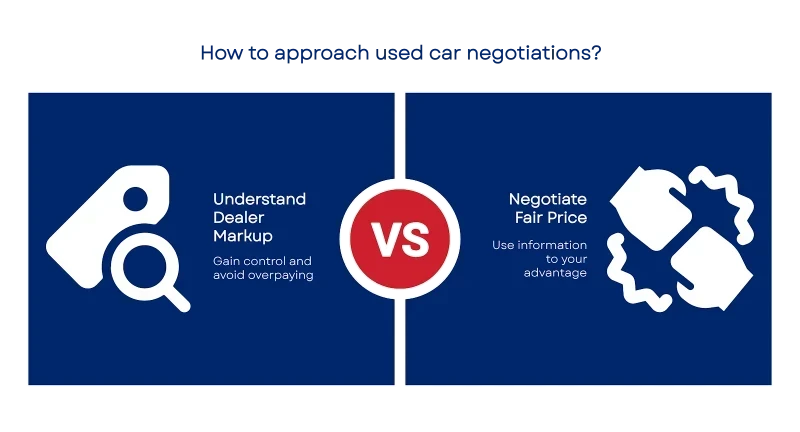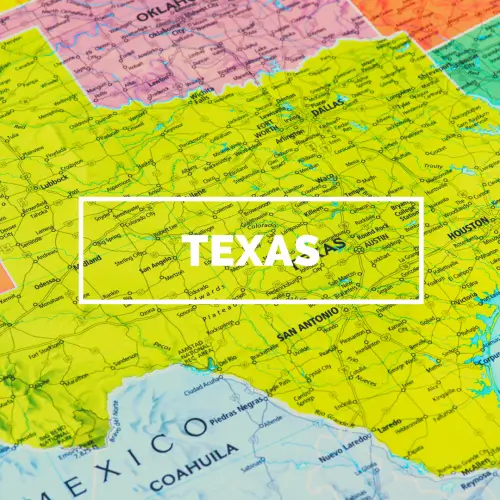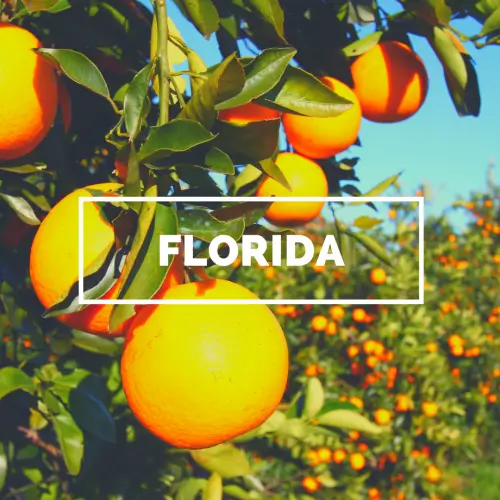On average, dealers add between 15% and 25% to the price they paid for the vehicle, which usually means paying $1,500 to $4,000 more than their cost, according to Edmunds. Knowing how much dealers typically markup used cars gives you more control during negotiations and helps you avoid overpaying, whether you're looking for a used Toyota or used hybrid cars.
In this article, you’ll see what a standard dealer markup looks like, what factors affect it, and how you can use this information to negotiate a fairer price.
What You’ll Learn
By the end of this article, you’ll know:
The typical dollar and percentage markups dealers add to used cars, and why they might be higher than you expect
The main factors that influence dealer pricing, and how to recognize when a price is inflated
Practical steps you can take to negotiate a better deal and avoid unnecessary fees
These points will help you make a more informed choice the next time you shop for a used car.
Summary
Car dealers add significant markups to used vehicles, but understanding exactly how much can help you negotiate better deals and avoid overpaying. This comprehensive guide reveals the real numbers behind dealer used car markups in the United States.
The Basic Markup Range
Most used car dealers mark up their vehicles by $1,500 to $4,000 above their acquisition cost, with the average markup falling around $2,000 to $2,500 per vehicle. In percentage terms, typical markups range from 10% to 35%, with 15-25% being most common.
For example, if a dealer purchases a used car for $15,000 at auction, they might sell it for $17,500 to $20,000, representing a markup of $2,500 to $5,000, or roughly 17% to 33%.
How Dealers Calculate Markups
Used car pricing isn't arbitrary. Dealers use sophisticated methods to determine markups:
Market-Based Pricing: Dealers rely on pricing software that analyzes comparable vehicles in their area, setting prices at 95-98% of market value to move inventory quickly. This approach prioritizes inventory turnover over maximum profit margins.
Cost-Plus Method: Dealers add their desired profit margin to the total cost of acquiring and preparing the vehicle. The formula typically includes:
Purchase price (auction, trade-in, or wholesale)
Reconditioning costs ($300-$2,000 per vehicle)
Holding costs ($40-$85 per day)
Overhead allocation
Factors That Influence Markup Amounts
Vehicle Type and Value
Luxury and Exotic Cars: Higher-end vehicles can see markups of $10,000-$30,000 due to a limited supply and strong demand. These vehicles may sit on lots for longer periods, but generate substantially higher profits.
Economy Vehicles: Common cars typically have smaller dollar markups but higher percentage markups relative to their lower values.
Market Conditions
High-Demand Models: Popular vehicles with limited availability command premium markups. In 2025, market conditions have created opportunities for dealers to maintain more substantial margins due to inventory constraints.
Aged Inventory: Vehicles sitting on lots for 60-90 days face significant pressure for price reductions or wholesale disposal, as holding costs accumulate rapidly.
Reconditioning Requirements
Dealers must factor in preparation costs when setting prices:
Minor work: $300-$600 (detailing, minor cosmetic fixes)
Moderate reconditioning: $800-$1,500 (mechanical and cosmetic work)
Major reconditioning: $2,000+ (engine work, extensive repairs)
Average reconditioning costs are approximately $1,112 per vehicle, although this varies significantly depending on the vehicle's condition and the dealer's standards.
Regional and Dealership Variations
Markup practices vary considerably across different markets and dealer types:
Independent vs. Franchise Dealers: Independent dealers typically achieve a net profit of $1,500 per vehicle, while franchise dealers average $2,000. However, franchise dealers often have higher overhead costs.
Geographic Differences: Market dynamics vary by region, with urban markets typically seeing more competitive pricing than rural areas where dealer density is lower.
State Regulations: Some states limit specific dealer fees. For example, New York caps collision damage waiver fees at $15 per day, which affects overall profitability calculations.
Hidden Costs That Increase Total Markup
Beyond the base markup, dealers add various fees that increase total profit:
Reconditioning Fees: Separate charges of $500-$2,000 that dealers claim cover vehicle preparation costs. These fees are often negotiable.
Administrative Fees: Processing charges typically range from $50 to $250.
Documentation Fees: Paperwork handling fees that vary by state regulations.
Extended Warranties and Add-ons: Finance and insurance products can add $1,000 to $2,000 in additional profit per vehicle.
The Real Cost of Dealer Operations
Understanding dealer costs helps explain the necessity of markup:
Holding Costs: Used vehicles incur dealers $40-$85 per day in carrying costs, including floor plan interest, insurance, and facility expenses.
Inventory Investment: Dealers typically invest $15,000 to $20,000 per vehicle in acquisition costs, requiring significant capital.
Operating Expenses: Total dealership operating costs can range from $74,500 to $294,000 per month, requiring substantial gross profit margins to remain viable.
Profit Margin Reality
Despite significant dollar markups, actual profit margins are more modest than many consumers believe:
Gross Profit: Used car dealers typically achieve gross profit margins of 12-15% on their retail sales.
Net Profit: After all expenses, net profit margins fall to just 1-2% of total sales.
Average Annual Profit: A typical used car dealership might generate $740,000 to $1.4 million in net profit annually on $74 million in sales.
Current Market Trends (2025)
Recent market conditions have created unique opportunities for dealer markups:
Rising Wholesale Prices: Cox Automotive's Manheim Used Vehicle Value Index reached 208.2 in April 2025, representing a 4.9% year-over-year increase, which provides dealers with greater potential for substantial markup.
Supply Constraints: The reduced inventory resulting from pandemic-era production cuts continues to support higher margins.
Consumer Behavior: Buyers are increasingly moving away from waiting for lower prices, creating a sense of urgency that supports dealer pricing power.
Negotiation Strategies
Understanding dealer markup gives consumers negotiation leverage:
Research Market Values: Use resources like KBB, Edmunds, and local listings to understand fair market pricing before negotiating.
Focus on Total Price: Negotiate the out-the-door price rather than haggling over individual fees and markups.
Timing Matters: Dealers are more willing to negotiate on vehicles approaching 60-90 days on the lot due to mounting holding costs.
Consider Alternatives: Getting quotes from services like CarMax, Carvana, or multiple dealers creates competitive pressure.
Markups of $1,500-$4,000 by used car dealers are a standard practice driven by legitimate business costs and market conditions. While these markups may seem substantial, they reflect the reality of dealer operations, including acquisition costs, reconditioning expenses, carrying costs, and overhead.
For consumers, the key is understanding that markup is part of the used car ecosystem while ensuring you're paying fair market value. Armed with research and negotiation skills, you can work within this system to secure reasonable deals that work for both you and the dealer.
The used car market in 2025 continues to favor dealers with more substantial margins than in previous years, making informed shopping and negotiation more critical than ever for consumers seeking value in their vehicle purchases.
Why You Need to Know How Much Dealers Mark Up Used Cars
Paying the sticker price on a used car without understanding dealer markup can cost you more than you need to spend. Dealers count on buyers not knowing what they paid for the vehicle. That gap between what they paid and what you pay is their profit.
Dealers deserve to earn a profit, but many buyers don’t realize the extent to which they can negotiate. Knowing the typical markup gives you an advantage when discussing price. You can recognize when the markup is higher than usual and push back with confidence.
Why It’s Important to Know Dealer Markups
Knowing how much dealers mark up used cars gives you leverage. It helps you avoid paying more than the car is worth and puts you in control of the conversation.
Dealers operate on thin margins overall, but individual vehicles often have more markup than buyers expect. Being aware of the usual range shows the dealer you’ve done your homework and makes it easier to negotiate a fairer price.
The Basic Markup Range You Can Expect
Most dealers add between $1,500 and $4,000 to the price they paid for a used car. The average markup falls around $2,000 to $2,500 per vehicle.
In percentage terms, markups usually range from 15 to 25 percent. In some cases, they can go as high as 35 percent.
Here’s an example:
Understanding these figures helps you recognize when a price is fair and when it’s inflated.
How Dealers Calculate Markups
Used car prices are not set randomly. Dealers use specific methods and account for all their business expenses when determining their pricing. Understanding how they calculate markups can help you figure out where there’s room to negotiate.
Here are the primary pricing methods dealers use:
Cost-plus method: Dealers calculate their total investment in the car, then add their desired profit margin. This is the most common approach.
Market-based pricing: Dealers use software tools that compare similar cars in the local market. Prices are typically set at approximately 95 to 98 percent of the current market value. This approach prioritizes selling cars quickly over maximizing profit.
The total investment includes:
Holding costs: Daily expenses while the car sits on the lot, including interest on loans, insurance, and lot space. These typically cost between $40 and $85 per day.
Overhead costs: A share of the dealership’s monthly operating expenses, like rent, utilities, payroll, and insurance.
Purchase price: What the dealer paid at auction, on a trade-in, or through a wholesaler.
Reconditioning costs: Expenses for repairs, maintenance, detailing, and cosmetic fixes. These can range from $300 for minor work to more than $2,000 for major repairs. The national average is about $1,112 per car.
By the time all these costs are added up, the dealer then adds a profit margin. That’s the markup you see on the sticker price.
When you understand what’s behind the price, it’s easier to see where there’s flexibility and where there isn’t.
Factors That Influence How Much Markup Dealers Add
Dealer markups vary from one car to another. Several factors influence the amount added to the price. Knowing these factors helps you spot when a car is priced higher than expected.
Vehicle type and value
Luxury and exotic cars often have significantly larger markups, sometimes ranging from $10,000 to $30,000, due to their limited supply and high demand. Economy cars usually carry smaller dollar markups but can have higher percentage markups compared to their lower cost.
Market conditions
When specific models are in high demand or there’s limited inventory, dealers keep prices higher. In contrast, if a car has been sitting on the lot for 60 to 90 days, the dealer is often more willing to reduce the price to avoid mounting holding costs.
Reconditioning requirements
Cars that need more repairs and prep work cost the dealer more upfront, which can lead to a higher asking price. Minor work, such as detailing and touch-ups, may cost between $300 and $600. Moderate mechanical or cosmetic repairs can add $800 to $1,500 to the cost. Major repairs, such as engine work, can cost more than $2,000.
Regional and dealership differences
Franchise dealerships tend to have higher markups than independent dealers, often because of higher overhead. Pricing also varies by location. Urban areas with more competition usually have more aggressive pricing than rural areas with fewer options. State regulations can also impact the fees dealers charge for documentation and other services.
Certified pre-owned vehicles often carry a higher markup than similar non-certified cars due to the added inspections and warranties. If you’re unsure which is better for you, this CPO vs. used cars guide clearly explains the pros and cons.
Hidden Costs to Watch Out For
Besides the standard markup on the sticker price, many dealers include additional fees and products in the final paperwork. These costs increase the total amount you pay and often go unnoticed until you’re signing. Understanding these charges helps you make informed decisions and push back when they’re unreasonable.
Reconditioning fees
Some dealers break out reconditioning as a separate line item, even though it’s already part of their cost structure. They may claim that the fee covers repairs, cleaning, and safety checks to prepare the car for sale. These fees typically range from $500 to $2,000. Since this work is generally part of selling any used car, you can usually negotiate this fee down or request that it be removed entirely.
Administrative and documentation fees
These cover the dealer’s internal paperwork and title transfer processing. The amount varies by state laws and dealer practices, but is commonly between $50 and $250. Some states regulate these fees, so it’s worth checking what is allowed in your state before agreeing to pay.
Finance and insurance products
Dealers often offer optional products, such as extended warranties, service contracts, tire and wheel protection, and paint sealants. These are usually presented during financing discussions and can add $1,000 to $2,000 or more to the total price. These products are not required to complete your purchase, and you can shop around for similar coverage elsewhere.
Other potential add-ons
Some contracts include extras like window etching, VIN registration, nitrogen-filled tires, or aftermarket alarms. While these may sound useful, they’re often priced far above their actual cost and provide little value.
When you’re ready to agree on a price, always request a detailed breakdown of all fees and add-ons. Instead of arguing each item individually, you can negotiate for a lower out-the-door price that works for you. This keeps the process simple and avoids surprises at the end.
When evaluating vehicles, also consider reliability. Some brands are consistently better bets than others. Here’s a helpful list of the most reliable used car brands to get you started.
Current Market Trends in 2025
The used car market in 2025 continues to favor dealers. Several trends have kept prices higher than in previous years, which affects how much room you have to negotiate.
Buyer urgency: Many buyers are less willing to wait for prices to drop, giving dealers more pricing power.
Higher wholesale prices: The Manheim Used Vehicle Value Index, which tracks wholesale prices, rose nearly five percent year over year in April. Dealers are paying more to acquire cars, which pushes retail prices up as well.
Limited inventory: The supply remains tight due to pandemic-era production cuts that reduced the number of cars entering the market.
These trends mean dealers are holding firm on markups in many cases. It’s even more important to research fair market value before you visit the lot, so you know where the price should land.
How to Negotiate Better Deals
You can still avoid overpaying for a used car by preparing and staying focused during the process. Here are the steps you can follow:
1. Research market prices
When researching fair prices, use trusted sources like Kelley Blue Book and Edmunds, as well as these 20 best used car sites, to compare listings and understand market value. Write down the range so you have a reference.
2. Compare multiple dealers
Obtain price quotes from multiple dealerships and online services, such as CarMax or Carvana. Let each dealer know you're comparing offers. This creates competition and gives you more leverage in negotiations.
3. Focus on the total out-the-door price
When negotiating, discuss the total price you’ll pay, including taxes and fees. Avoid getting pulled into separate discussions about each fee or add-on.
4. Check the car’s time on the lot
Ask how long the car has been in inventory. Vehicles sitting for 60 to 90 days incur a daily cost for the dealer. They may be more willing to lower the price to move it.
5. Be ready to walk away
If the dealer won’t work with you or the price feels too high, thank them and leave. You can always follow up later or find another car.
Following these steps gives you a better chance at paying a fair price and avoiding unnecessary fees.
Final Thoughts
Used car dealer markups are a regular part of the business, but you don’t have to accept the first price you see. Knowing the typical markup range, what drives it, and how to identify extra fees gives you a competitive advantage.
Used cars remain a smart way to save money while still enjoying desirable features. As Consumer Reports points out, buying used can put luxury, comfort, and safety features within reach at a lower cost. Take time to research, compare offers, and stay focused on the total price. Dealers respect buyers who come prepared and ask clear questions.
The next time you shop for a used car, apply what you’ve learned here to get a fair price and keep more money in your pocket.
Need Help Shipping Your Car?
If you’re buying or selling a used car and need it shipped anywhere in the country, we can help. At AmeriFreight Auto Transport, we work with trusted carriers to move your vehicle safely and efficiently, offering both open and enclosed transport options.
We’ll explain your options, answer your questions, and help you schedule transport when you’re ready. Our team is here to guide you through every step and help you choose the best option for your timeline and budget.
Request an estimate today and let us make your car shipping experience as simple as possible.
Frequently Asked Questions (FAQs)
Are there hidden fees or charges that contribute to the markup on used cars at dealerships?
Yes. Dealers often add fees for reconditioning, paperwork, and optional add-ons. Always ask for the full price breakdown.
How does the age of a used car affect the dealer's markup percentage?
Older cars often have higher percentage markups since their base price is lower.
When is the best time of year to buy a used car in the US to potentially find lower dealer markups?
End of the month, quarter, or year. Fall and winter often offer better deals as well.
Are certified pre-owned (CPO) vehicles typically marked up more than non-CPO used cars at dealerships?
Yes. CPO cars cost more because of added inspections and warranty coverage.
Disclaimer: This article is for general information only and does not constitute financial or legal advice. Always consult a professional before making major purchasing decisions.
















